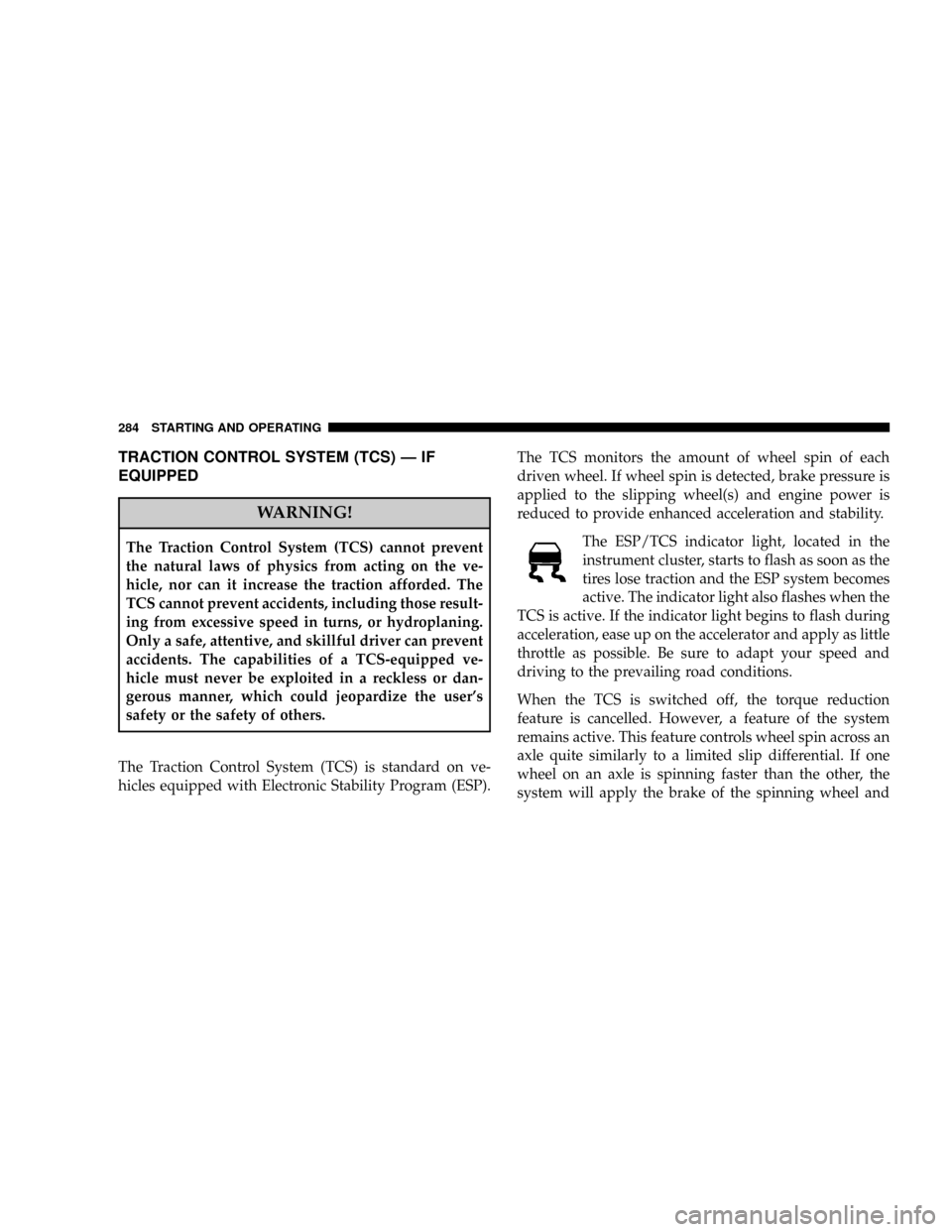2008 DODGE CHARGER tire pressure
[x] Cancel search: tire pressurePage 65 of 466

²Traction/stability control status
²Tire pressure monitoring system status (if equipped)
Child Restraint
Everyone in your vehicle needs to be buckled up all the
time Ð babies and children, too. Every state in the United
States and all Canadian provinces require that small
children ride in proper restraint systems. This is the law,
and you can be prosecuted for ignoring it.
Children 12 years and under should ride properly buck-
led up in a rear seat, if available. According to crash
statistics, children are safer when properly restrained in
the rear seats rather than in the front.
WARNING!
In a collision, an unrestrained child, even a tiny baby,
can become a missile inside the vehicle. The force
required to hold even an infant on your lap could
become so great that you could not hold the child, no
matter how strong you are. The child and others could
be badly injured. Any child riding in your vehicle
should be in a proper restraint for the child's size.
There are different sizes and types of restraints for
children from newborn size to the child almost large
enough for an adult safety belt. Always check the child
seat Owner's Manual to ensure you have the correct seat
for your child. Use the restraint that is correct for your
child:
THINGS TO KNOW BEFORE STARTING YOUR VEHICLE 65
2
Page 78 of 466

Periodic Safety Checks You Should Make Outside
The Vehicle
Tires
Examine tires for excessive tread wear and uneven wear
patterns. Check for stones, nails, glass, or other objects
lodged in the tread. Inspect the tread and sidewall for
cuts and cracks. Check the wheel nuts for tightness.
Check the tires (including spare) for proper pressure.
Lights
Have someone observe the operation of exterior lights
while you work the controls. Check turn signal and high
beam indicator lights on the instrument panel.
Door Latches
Check for positive closing, latching, and locking.
Fluid Leaks
Check area under vehicle after overnight parking for fuel,
engine coolant, oil, or other fluid leaks. Also, if gasoline
fumes are detected or if fuel, power steering fluid, or
brake fluid leaks are suspected, the cause should be
located and corrected immediately.
78 THINGS TO KNOW BEFORE STARTING YOUR VEHICLE
Page 172 of 466

21. Vehicle Security Alarm (VSA) Indicator Light Ð If
Equipped
The VSA indicator Light flashes rapidly when the VSA is
arming, and slowly when the VSA is armed. (See page 18
for more information.)
22. Tire Pressure Monitoring Telltale Light Ð If
Equipped
Each tire, including the spare (if provided),
should be checked monthly when cold and
inflated to the inflation pressure recommended
by the vehicle manufacturer on the vehicle
placard or tire inflation pressure label. (If your vehicle
has tires of a different size than the size indicated on the
vehicle placard or tire inflation pressure label, you should
determine the proper tire inflation pressure for those
tires.)
As an added safety feature, your vehicle has been
equipped with a tire pressure monitoring system (TPMS)that illuminates a low tire pressure telltale when one or
more of your tires are significantly under-inflated. Ac-
cordingly, when the low tire pressure telltale illuminates,
you should stop and check your tires as soon as possible,
and inflate them to the proper pressure. Driving on a
significantly under-inflated tire causes the tire to over-
heat and can lead to tire failure. Under-inflation also
reduces fuel efficiency and tire tread life, and may affect
the vehicle's handling and stopping ability.
Please note that the TPMS is not a substitute for proper
tire maintenance, and it is the driver 's responsibility to
maintain correct tire pressure, even if under-inflation has
not reached the level to trigger illumination of the TPMS
low tire pressure telltale.
Your vehicle has also been equipped with a TPMS
malfunction indicator to indicate when the system is not
operating properly. The TPMS malfunction indicator is
combined with the low tire pressure telltale. When the
172 UNDERSTANDING YOUR INSTRUMENT PANEL
Page 173 of 466

system detects a malfunction, the telltale will flash for
approximately one minute and then remain continuously
illuminated. This sequence will continue upon subse-
quent vehicle start-ups as long as the malfunction exists.
When the malfunction indicator is illuminated, the sys-
tem may not be able to detect or signal low tire pressure
as intended. TPMS malfunctions may occur for a variety
of reasons, including the installation of replacement or
alternate tires or wheels on the vehicle that prevent the
TPMS from functioning properly. Always check the
TPMS malfunction telltale after replacing one or more
tires or wheels on your vehicle to ensure that the replace-
ment or alternate tires and wheels allow the TPMS to
continue to function properly. (See page 309 for more
information.)CAUTION!
The TPMS has been optimized for the original
equipment tires and wheels. TPMS pressures and
warning have been established for the tire size
equipped on your vehicle. Undesirable system opera-
tion or sensor damage may result when using re-
placement equipment that is not of the same size,
type, and/or style. Aftermarket wheels can cause
sensor damage. Do not use aftermarket tire sealants
or balance beads if your vehicle is equipped with a
TPMS, as damage to the sensors may result.
23. Anti-Lock Brake Light Ð If Equipped
This light monitors the Anti-Lock Brake System.
The light will turn on when the ignition switch is
turned to the ON position and may stay on for as long as
four seconds.
UNDERSTANDING YOUR INSTRUMENT PANEL 173
4
Page 252 of 466

mDriving On Slippery Surfaces..............275
NAcceleration.........................275
NTraction............................275
mDriving Through Water..................276
NFlowing/Rising Water..................276
NShallow Standing Water.................276
mParking Brake.........................278
mBrake System..........................280
NAnti-Lock Brake System Ð If Equipped.....280
mPower Steering........................282
mMulti Displacement System (MDS) Ð 5.7L Engine
Only................................283
mTraction Control System (TCS) Ð If Equipped . . 284mBrake Assist System (BAS) Ð If Equipped.....285
mElectronic Stability Program (ESP) Ð
If Equipped...........................286
NSynchronizing ESP....................289
NESP/BAS Malfunction Indicator And ESP/TCS
Indicator Lights......................289
mTire Safety Information...................290
NTire Markings........................290
NTire Identification Number (TIN)..........293
NTire Loading And Tire Pressure...........294
mTires Ð General Information...............298
NTire Pressure.........................298
NTire Inflation Pressures.................299
NRadial-Ply Tires......................301
252 STARTING AND OPERATING
Page 253 of 466

NCompact Spare Tire Ð If Equipped.........302
NLimited Use Spare Ð If Equipped.........302
NTire Spinning........................303
NTread Wear Indicators..................304
NLife Of Tire.........................304
NReplacement Tires.....................305
NAlignment And Balance.................306
mSelf-Sealing Tires Ð If Equipped............307
mTire Chains...........................307
mSnow Tires...........................308
mTire Rotation Recommendations............308
mTire Pressure Monitor System (TPMS) Ð
If Equipped...........................309NBase System Ð If Equipped..............312
NPremium System Ð If Equipped..........314
NGeneral Information...................318
mFuel Requirements......................319
N2.7L Engine.........................319
N3.5L And 5.7L Engines..................319
NReformulated Gasoline.................320
NGasoline/Oxygenate Blends..............320
NMMT In Gasoline.....................321
NMaterials Added To Fuel................321
NFuel System Cautions..................321
NCarbon Monoxide Warnings..............322
mAdding Fuel..........................323
STARTING AND OPERATING 253
5
Page 284 of 466

TRACTION CONTROL SYSTEM (TCS) Ð IF
EQUIPPED
WARNING!
The Traction Control System (TCS) cannot prevent
the natural laws of physics from acting on the ve-
hicle, nor can it increase the traction afforded. The
TCS cannot prevent accidents, including those result-
ing from excessive speed in turns, or hydroplaning.
Only a safe, attentive, and skillful driver can prevent
accidents. The capabilities of a TCS-equipped ve-
hicle must never be exploited in a reckless or dan-
gerous manner, which could jeopardize the user's
safety or the safety of others.
The Traction Control System (TCS) is standard on ve-
hicles equipped with Electronic Stability Program (ESP).The TCS monitors the amount of wheel spin of each
driven wheel. If wheel spin is detected, brake pressure is
applied to the slipping wheel(s) and engine power is
reduced to provide enhanced acceleration and stability.
The ESP/TCS indicator light, located in the
instrument cluster, starts to flash as soon as the
tires lose traction and the ESP system becomes
active. The indicator light also flashes when the
TCS is active. If the indicator light begins to flash during
acceleration, ease up on the accelerator and apply as little
throttle as possible. Be sure to adapt your speed and
driving to the prevailing road conditions.
When the TCS is switched off, the torque reduction
feature is cancelled. However, a feature of the system
remains active. This feature controls wheel spin across an
axle quite similarly to a limited slip differential. If one
wheel on an axle is spinning faster than the other, the
system will apply the brake of the spinning wheel and
284 STARTING AND OPERATING
Page 290 of 466

TIRE SAFETY INFORMATION
Tire Markings
NOTE:
²P (Passenger)-Metric tire sizing is based on U.S. design
standards. P-Metric tires have the letter ªPº molded
into the sidewall preceding the size designation. Ex-
ample: P215/65R15 95H.
²European Metric tire sizing is based on European
design standards. Tires designed to this standard have
the tire size molded into the sidewall beginning with
the section width. The letter9P9is absent from this tire
size designation. Example: 215/65R15 96H
²LT (Light Truck)-Metric tire sizing is based on U.S.
design standards. The size designation for LT-Metric
tires is the same as for P-Metric tires except for the
letters ªLTº that are molded into the sidewall preced-
ing the size designation. Example: LT235/85R16.
²Temporary Spare tires are high-pressure compact
spares designed for temporary emergency use only.
Tires designed to this standard have the letter ªTº
molded into the sidewall preceding the size designa-
tion. Example: T145/80D18 103M.
²High Flotation tire sizing is based on U.S. design
standards and it begins with the tire diameter molded
into the sidewall. Example: 31x10.5 R15 LT.
290 STARTING AND OPERATING